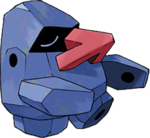Nosepass

| |||
| The Compass Pokémon | |||
| #299 - Nosepass | |||
| Evolve | Probopass | ||
| Debut | Pokémon: Sapphire Version Pokémon: Ruby Version | ||
| Species Info | |||
| Type | |||
| Height | 1.0 m (3'03") | ||
| Weight | 97.0 kg (213.8 lbs.) | ||
| Color | Gray | ||
| Gender Ratio | 1♂ : 1♀ | ||
| Ability | Sturdy / Magnet Pull | ||
| Hidden Ability | Sand Force | ||
| Egg Group | Mineral | ||
| Icon | Sprite | ||
| File:299sprite.png | |||
| Footprint | |||
| 30px | |||
| Base Statistics | |||
| Hit Points | 30 | Speed | 30 |
| Attack | 45 | Sp. Attack | 45 |
| Defense | 135 | Sp. Defense | 90 |
| Training Info | |||
| Catch Rate | 255 | Hatch Steps | 5,120 |
| Base Exp. | 108 | Effort Points | Def |
| Happiness | 70 | ||
| To Lv.100 | Normal | ||
| Kanto # | Johto # | Hoenn # | Sinnoh # |
|---|---|---|---|
| < 299 > | < 060 > | < 155 > | |
| Unova # | Johto (IV) # | ||
Nosepass is a magnetic monolith-like Pokémon that was introduced in the third generation games. It did not have an evolutionary line until the fourth generation introduced Probopass as its evolved form, which can only be reached under special conditions.
Information[edit]
Nosepass has a large magnetic nose which is perpetually pointing north. They have been said to be constantly unmoving, but closer observations have shown that they actually move about three-eighths of an inch per year. Travelers often check Nosepass due to its magnetic properties. If two Nosepass meet, they cannot face each other too close or their magnetic noses will repel each other. Nosepass utilizes the powerful magnetism that it emits, as it feeds on prey that is pulled in by the magnetic force. Its magnetic field is stronger during cold seasons.
When endangered, it protects itself by pulling in iron objects with a raised magnetic force to shield itself. Nosepass can only evolved into Probopass when leveling up in an area with certain magnetic properties, such as areas within Mt. Coronet in Sinnoh and Chargestone Cavern in Unova.
Appearances[edit]
Mainstream Games[edit]
In Pokémon: Ruby, Sapphire and Emerald Versions, Nosepass could be found somewhat commonly by smashing rocks at Granite Cave. In Diamond and Pearl, they appeared at Route 206 during swarms, while in Platinum, they were rarely found at Mt. Coronet. In HeartGold and SoulSilver, Nosepass could appear at the Safari Zone's Meadow area when enough Rock objects were present.
Other Games[edit]
In Pokémon XD: Gale of Darkness, a Shadow Nosepass could be snagged from Miror B. at Phenac Stadium, and after being purified it could be traded to any of the third generation color versions. In Pokémon Pinball: Ruby & Sapphire, it could be caught at the Cave. In Pokémon Trozei!, it was found at Endless Level 44, Forever Level 9, Pair Trozei and Mr. Who's Den. In Pokémon Mystery Dungeon: Red and Blue Rescue Teams, it could be recruited at the third through sixth floors of Frosty Forest, the first six floors of Desert Region and the eleventh through twelfth basement floors of Oddity Cave, while in Explorers of Time and Darkness it was recruitable at Blizzard Island, Crevice Cave and Mt. Avalanche. In Pokémon Ranger: Shadows of Almia, Nosepass was found at Marine Cave.
Other Appearances[edit]
Other Media[edit]
- In the Pokémon anime, Nosepass was featured as Roxanne's main Pokémon during her gym battle with Ash. It gave Ash's Pikachu a hard time until Pikachu was able to beat it when it perfected its newly-learned Iron Tail move. Nosepass have appeared belonging to trainers in several other episodes, such as one episode of the Hoenn series that featured a trainer named Hank who was using his Nosepass to track his Aipom which was wearing a metal crown. An episode of the Sinnoh series also featured a trainer named Alan who owned a Nosepass which evolved into a Probopass due to Mt. Coronet's magnetic fields.
- In the Pokémon Adventures manga, Roxanne's Nosepass was featured during her battle with Sapphire in the Ruby/Sapphire arc where it gave her Aron a tough battle but ultimately was beaten. Roxanne also used it for battles later in the arc. During the Diamond/Pearl arc, Cyrus was briefly shown with both a Nosepass and Magneton at Mt. Coronet which he had evolve into Probopass and Magnezone.
Trivia[edit]
- Its name is a combination of "nose" (due of course to its large nose) and "compass" (due its always pointing north).
- Pages with broken file links
- Creatures
- Pokémon
- Rock Type Pokémon
- Gray Colored Pokémon
- Sturdy Ability Pokémon
- Magnet Pull Ability Pokémon
- Sand Force Ability Pokémon
- Mineral Egg Group Pokémon
- Pokémon that yield Def Points
- Pokémon with catch points
- Pokémon with hatching steps
- Pokémon with exp base
- Pokémon with happiness base
- Pokémon with Lv 100